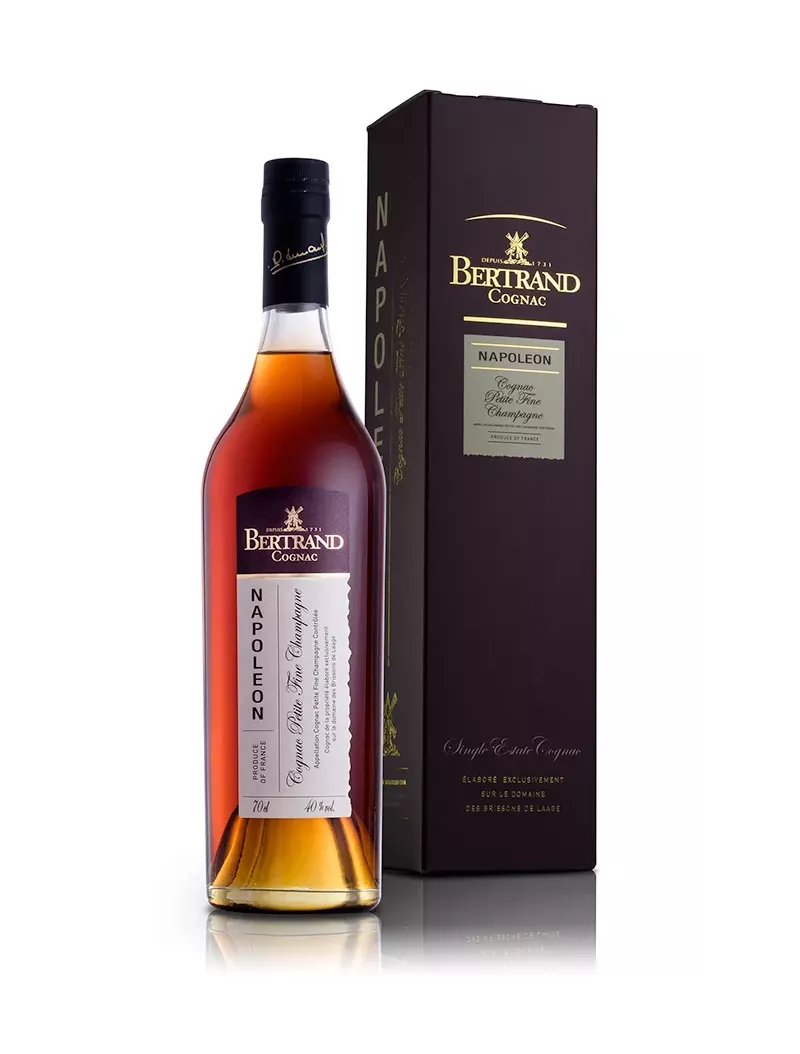- -10%
- Out of stock


This Napoléon cognac from Maison Bertrand stands out for its maturity and richness, the result of at least 20 years of aging in carefully selected oak barrels. Its age gives it a deep aromatic complexity, where woody, vanilla, and spicy notes intertwine, accompanied by subtle hints of ripe fruit and honey.
On the palate, it reveals a velvety and balanced texture, combining power and finesse, with generous flavors of dried fruit, roasted almond, and a touch of cinnamon that adds an elegant warmth. The finish is long, warm, and persistent, marked by a beautiful woody roundness.
Cognac Bertrand Napoléon 20 Years is an invitation to slow and thoughtful tasting, ideal for connoisseurs seeking a refined spirit rich in history and emotion.
Best enjoyed neat as a digestif.
Available starting September 29, 2025.

Free shipping on orders over 250€*
 100% secure payment
100% secure payment
Credit Card, Bank Transfer, PayPal,...)

Breakage-proof protected packaging
Nose: Excellent roundness, fruity and spicy notes.
Palate: Flavors of hazelnut, cocoa, and nutmeg.
Finish: Long and satisfying finish.
Awards:
2014, Beverage Testing Institute, Gold Medal, 93 Points.
The Vineyard: A Precious Land of Origin.
Everything begins with the terroir. Domaine Bertrand spans nearly 90 hectares, entirely located in Petite Champagne, the second most prestigious area within the Cognac AOC. Situated between Jonzac and Archiac, the vineyards flourish on limestone hills locally known as the "Petite Fine Champagne," a highly sought-after micro-terroir famous for producing eaux-de-vie that are powerful, complex, and built to age. The family vineyard is divided into three main parcels: around the estate lies the 40 hectares of Les Brissons, forming the historic heart of the domain; about ten more hectares thrive at "Chez Bruneteau"; and finally, the emblematic terroir of Laage, dominated by the sails of the Bel Air mill—now the house’s symbol—completes the estate with around 40 hectares. This diversity of soils and exposures creates a true mosaic of parcels, passionately managed year-round by Samuel Bertrand, Hervé Cormelier (technical director), and their team.
The Winemaker: A Daily Commitment.
This vast vineyard is carefully tended with respect for the environment. Each year, 3 to 5% of the vines are replanted to maintain the vineyard’s vitality and combat wood diseases. The grape varieties remain faithful to local tradition, with Ugni Blanc dominating due to its ideal acidity and consistency for distilling. Colombard, present on some parcels, adds a complementary aromatic touch. A few hectares of Merlot and Cabernet are also cultivated to produce rosé pineau. The chalky soils typical of Petite Fine Champagne ensure natural drainage, limiting yields but enhancing aromatic concentration. From vineyard work to harvest timing, every decision aims for optimal ripeness, depending on the vine’s age, orientation, and plot. According to Samuel Bertrand, “this is the crucial moment where everything is decided.”
Distillation: Tradition and Precision.
Distillation is a vital stage in the process, and Samuel Bertrand likes to remind that much of his expertise comes from the knowledge passed down through generations. After fermentation, the wines—without sulfites—are distilled before March 31st, in compliance with AOC regulations. At the estate, three copper stills are used, with careful attention to the origin of the wines and respecting parcel selection. True to local tradition, distillation is performed on the lees, which gives the eaux-de-vie aromatic richness and a smooth roundness. Day and night, the team monitors the heating stages—from the first pass to selecting the heart of the distillate.
“This moment is always moving,” confides Samuel Bertrand. “It is the first tangible expression of the work done in the vineyard and the beginning of crafting our cognacs.”
The Cellar: Where Time Works Its Magic.
Once distillation is complete, the young eaux-de-vie begin their long maturation. The first six months are spent in new Limousin oak barrels before being transferred to older casks, known as “fûts roux,” which allow for harmonious aging.
The estate has five cellars, each with its own atmosphere, contributing unique nuances: The Garnier cellar houses the young eaux-de-vie, The Pressoir cellar is reserved for pineau, The oldest cognacs rest in the Neuf cellar and the Cour cellar, the latter being the most humid. Finally, the cellar of the Old Distillery contains large barrels used for blending.
Thomas J. Hall, cellar master and family member, oversees the maturation meticulously. For him, “the diversity of our cellars is a treasure that allows us to build deep and varied aromatic profiles.”
The Bertrand Style: An Artisan Signature
Bertrand cognacs faithfully reflect their origin. Entirely from Petite Fine Champagne, they stand shoulder to shoulder with the greatest houses of Grande Champagne. The house style balances structure, finesse, and aromatic expression—a result of rigorous work from the soil to the cellar. Each terroir brings its own signature: the hills of Laage and Chez Bruneteau produce powerful, complex eaux-de-vie, while those from the Brissons plateau are more floral and delicate. “Blending is as much a science as it is an art,” explains Thérèse Bertrand, who, alongside other family members, participates in tasting committees.
The classic range (VS, VSOP, Napoléon, XO) embodies this consistency of style and quality, designed both for traditional enthusiasts and the mixology world. Additionally, the house occasionally releases limited editions—such as the Heritage cuvées—that pay tribute to ancestors and captivate collectors and aficionados. The pineaus, whether white, aged, or rosé, are crafted with the same high standards.

Data sheet